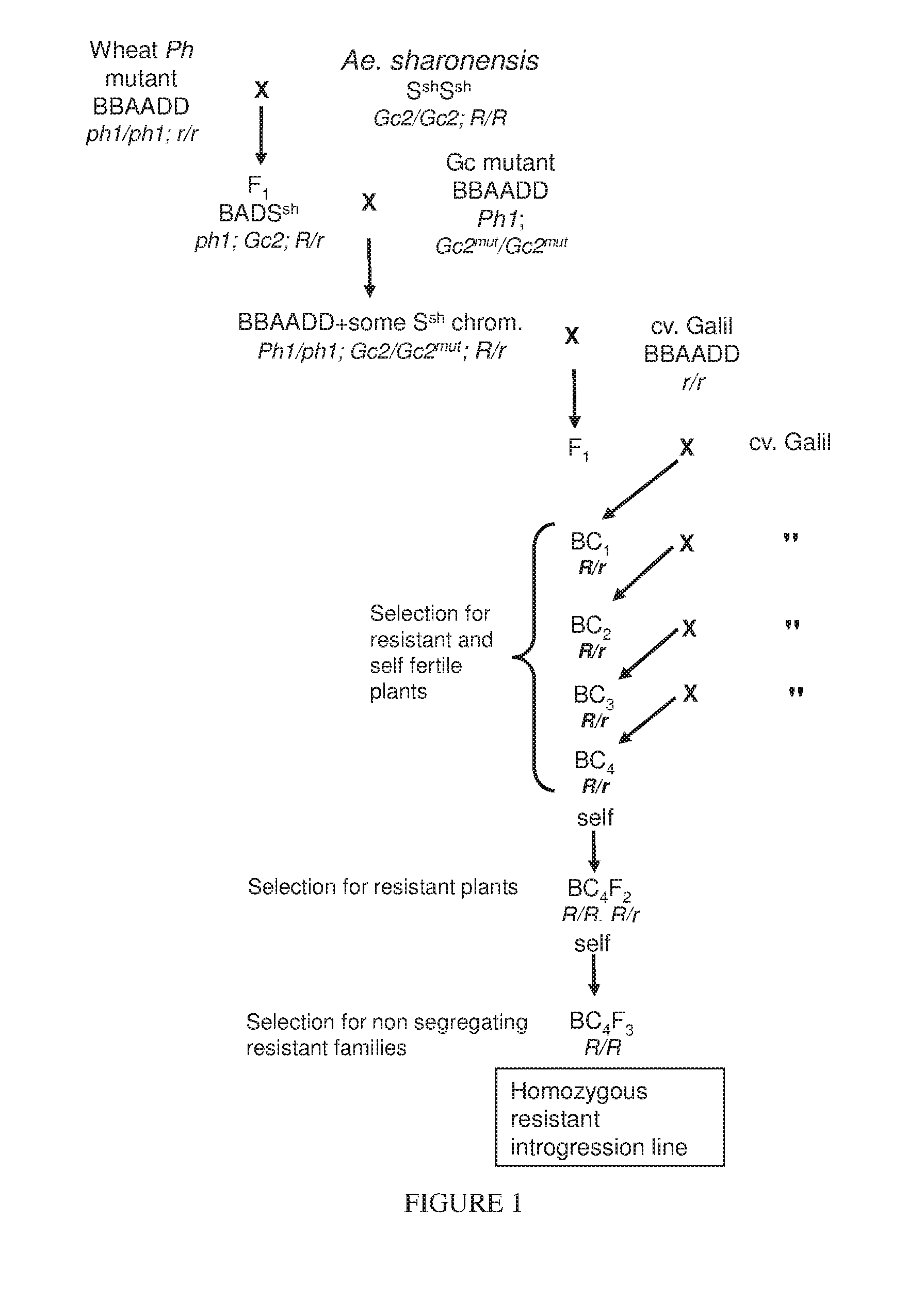Resistance to rust disease in wheat
a technology of rust disease and resistance to wheat, which is applied in the field of resistance to rust disease in wheat, can solve the problems of high yield loss annually, low hybrid seed set, and difficulty in gene transfer from sharon goatgrass, and achieve the effect of conferring or enhancing resistance to leaf rust and stripe rus
- Summary
- Abstract
- Description
- Claims
- Application Information
AI Technical Summary
Benefits of technology
Problems solved by technology
Method used
Image
Examples
example 1
Production of the Introgression Lines
[0144]By induction of homologous pairing using the gene transfer procedure described hereinabove a number of BC4F3 introgression lines homozygous resistant for certain pathotypes of leaf rust and / or yellow (stripe) rust causing fungi were obtained. The lines have agronomic appearance, resemble their recurrent parent cv. Galil and are self fertile. The lines can be used in breeding programs to improve wheat resistance to these diseases.
example 2
Leaf Rust Resistant Lines
[0145]One BC4 leaf rust resistant line, RL-17, was derived from pollination of the haploid hybrid (F1 Mph×AES) by the AG mutant. This line is characterized by large AES segment(s) spanning together the whole 6B chromosome. Nevertheless, two Galil markers were still present at positions 12.7 and 54.3 (chromotype a; FIG. 2). Three other leaf rust resistant lines (RL-76, RL-86 and RL-510) were derived from a cross of the haploid hybrid with cv. Galil before its offspring were pollinated by the AG mutant. All of these 3 lines had a similar short intercalary AES region of 22 cM on chromosome 6B; RL-510 being different from the two other lines by the absence of a couple of wheat markers at 50.6 cM (chromotypes b and c). Yet, within this region, two segments of Galil markers were found (ca. 30-38 cM and 47-50 cM). However, only three AES markers, namely aePt947170, aePt948067 and tPt0910 mapping to 38.5, 38.9 and 41.5 cM, respectively, were found in common with all...
example 3
Stripe Rust Resistance Lines
[0146]All of the BC4 stripe rust resistant lines were derived from pollination of the haploid hybrid (F1 Mph×AES) by the AG mutant followed by pollination of the offspring by cv. Galil. The chromosome constitution of lines RY-32-3-3 and RY-41 was similar to that of line RL-17 (AES segment(s) spanning the whole 6B chromosome with only 2 Galil markers; chromotype d, FIG. 3). Line RL32-3-14 had also long AES insertion (about 74 cM) but its telomeres were typically of Galil type. The two other lines showed a similar chromotypes (f and g). They both had an intercalary AES region between 38.5 and 48 cM followed by another region from 48 to 87 cM of mosaics of wheat and AES markers. Several distinct AES markers were common to all recombinant chromotypes: aePt947170 (mapped on 38.5 cM), tPt0910 (41.5 cM) aePt948252 (62.1 cM), aePt948565 and aePt947177 (66.5 cM) and aePt949079 (86.8 cM). It is noteworthy that only aePt947170 and tPt0910 were common to all the RL c...
PUM
| Property | Measurement | Unit |
|---|---|---|
| temperature | aaaaa | aaaaa |
| temperature | aaaaa | aaaaa |
| temperature | aaaaa | aaaaa |
Abstract
Description
Claims
Application Information
 Login to View More
Login to View More - R&D
- Intellectual Property
- Life Sciences
- Materials
- Tech Scout
- Unparalleled Data Quality
- Higher Quality Content
- 60% Fewer Hallucinations
Browse by: Latest US Patents, China's latest patents, Technical Efficacy Thesaurus, Application Domain, Technology Topic, Popular Technical Reports.
© 2025 PatSnap. All rights reserved.Legal|Privacy policy|Modern Slavery Act Transparency Statement|Sitemap|About US| Contact US: help@patsnap.com



